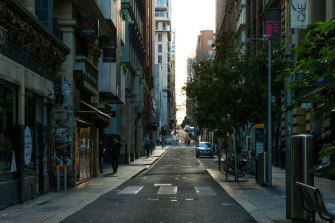Home » World News »
Unoccupied city speaks of unfulfilled dreams and wasted opportunities
When Premier Daniel Andrews posted a series of shots of empty freeways on Facebook recently with the caption “Thank you” the full, surreal, impact of what we’re doing hit me.
Lockdown bites: An empty Flinders Lane.Credit:Getty
Since Melbourne’s various and seemingly unending lockdowns and restrictions started, the regularity of our collective ebb and flow has been disrupted beyond all recognition.
Places where I used to be alone are suddenly filled with people. I used to step outside my front gate at 5am and take off on long bike rides with a sense that I owned the dawn and indeed the whole of the city; there was no one else to share it with me. Now I have to look both ways to avoid crashing into an early jogger or a gym-deprived walker bearing hand weights.
Places where I could once melt into the crowd, on the other hand, are eerie in their emptiness. The upmarket shops of Collins Street are as good as shuttered, windows bare of bling and lights kept low. Too many people where there should be none: not enough people where there should be many.
Now that Melbourne is under curfew I can only imagine the empty streets as I sit inside at night watching Netflix like all the other good upstanding citizens. I suppose those streets are much as they were on the morning of Anzac Day this year, when I left home before 5am and rode down through the CBD towards the bay. I didn’t see a single car or other human until I reached the Shrine, even on Swanston Street and outside Flinders Street Station.
And when I ride as far as Southbank (right on the edge of my five-kilometre “zone”), I find its wide promenades, usually thronged with tourists, workers and apartment dwellers, almost empty. The suburbs, though, are packed as everyone flocks to the few recreational spaces they can walk to in an hour.
Trying to understand why it felt so strange, I looked up Freud’s definition of the uncanny. He said: “The ‘uncanny’ is that class of the terrifying which leads back to something long known to us, once very familiar.”
That’s what spooks me. What seemed to be the natural order of things has been turned upside down, and it makes me ask: what else might not be as reliable as it seems?
The disconnect between what these places are built for – the seething, colourful mass of humanity – and what they now contain – a few pigeons and police – is what gives them poignancy. Like Hemingway’s (possibly apocryphal) six-word short story: “For sale: baby shoes, never worn”, an unoccupied city speaks of unfulfilled dreams, blighted plans and wasted opportunities.
The displacement of people into formerly empty spaces has its own strangeness. I would never complain about the hordes finding their way into the previously unoccupied pockets of time and space that used to be mine, but they’re disconcerting all the same. When I see, say, a cyclist checking his phone on the northern reaches of the Merri Creek bike trail early on a Sunday morning, presumably to find out where he is, I think about what it must be like to be a stranger in your own suburb.
It unsettles my sense of the city I know when I see places stripped of their meaning and history, either by new occupation or by losing their regular habitués.
These streets used to be so quiet; they used to be so busy too. Nothing, physically, has changed in Melbourne’s streets, but I know things will never be the same.
Jenny Sinclair is a Melbourne writer.
Most Viewed in National
Source: Read Full Article



